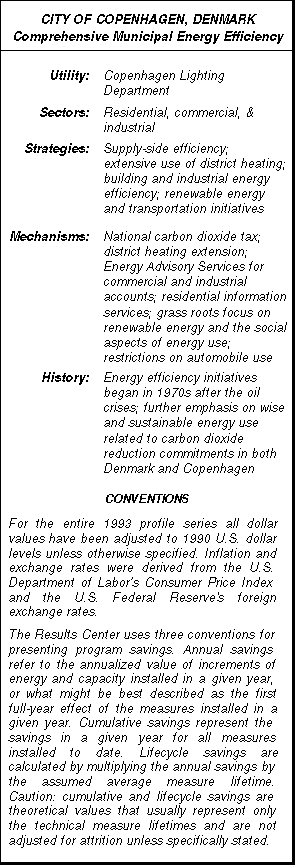IIEC Recent News
Copenhagen, Denmark, Comprehensive Municipal Energy Efficiency (resid'l/com'l/ind'l), Profile #80
EXECUTIVE SUMMARY
 Copenhagen is a leading city in terms of energy efficiency, and like other European leaders profiled by The Results Center, its efforts have been broad and have spanned supply-side efficiency, the aggressive promotion of district heating, energy efficiency initiatives, renewable energy developments, and transportation. Together these efforts are providing a framework for Copenhagen’s commitment to carbon dioxide reductions and to decreasing its dependence on foreign energy supplies. In fact, in 1991 Denmark as a whole became self-sufficient in its oil and gas use as compared with 1973 when it imported 100% of its oil.
Copenhagen is a leading city in terms of energy efficiency, and like other European leaders profiled by The Results Center, its efforts have been broad and have spanned supply-side efficiency, the aggressive promotion of district heating, energy efficiency initiatives, renewable energy developments, and transportation. Together these efforts are providing a framework for Copenhagen’s commitment to carbon dioxide reductions and to decreasing its dependence on foreign energy supplies. In fact, in 1991 Denmark as a whole became self-sufficient in its oil and gas use as compared with 1973 when it imported 100% of its oil.
Copenhagen’s largest singular achievement with energy management has been the construction of what will become the largest district heating system in the Western world. This network now supplies 67% of the space heating demands of the City, and when complete in the year 2002 will supply fully 95% of the space heating demands of Copenhagen.
The City of Copenhagen has implemented demand-side management programs using an approach that is based on energy advisory services. This approach underscores the City’s commitment to provide its energy customers with appropriate price signals and then to inform its customers that energy efficiency upgrades are in their best interest. Thus the ultimate costs of efficiency are borne by the customers and the total costs of DSM are moved off the utility’s balance sheet. Nevertheless, the City projects that these services will provide 265 GWh annually by the year 2005.
Like the City of Oslo, Norway, (See Profile #79) The Copenhagen Lighting Department collects revenues to fund its efficiency efforts through the use of a small surcharge, equal to less than half a percent of the current average kWh rate, applied to every kilowatt-hour sold. These resulting funds have been used to hire skilled energy engineers who prepare detailed energy surveys of the City’s largest energy consumers and to support the downtown energy center and its staff, plus various energy efficiency campaigns.
While the overall picture of responsible energy use in Denmark is epitomized by Copenhagen’s comprehensive initiatives, the City is plagued by the erosion of savings that challenges energy efficiency initiatives around the world. Despite high prices and a series of factors intended to discourage automobile use, it is nevertheless on the rise in Copenhagen. Similarly, the dramatic influx of waterbeds in Denmark has created a demand for electricity that is greater than the entire country’s wind generation capability! Thus the model presented in Copenhagen, which provides for a host of innovative and progressive policies and practices, is complete with challenges and opportunities that will be watched carefully by countries similarly committed to carbon dioxide reductions in the coming years.
[CLICK HERE TO DOWNLOAD THE ENTIRE 23 PAGE PROFILE IN PDF FILE FORMAT]
This profile was produced by

